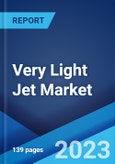Very light jet is a compact, entry-level aircraft that can sustain up to 13,000 lbs. or 5,900 kilograms of take-off weight, with a seating capacity of fewer than ten passengers. Typically approved for single-pilot operation, these jets are operated through a conventional fuel propulsion system. However, with continual technological advancements, hybrid or electric propulsion systems are also gaining traction. Some of the major advantages provided by these jets include cost-effectiveness and fuel efficiency. Besides this, since the jets are very light in weight, the flying duration is greatly shortened with a strong engine and up to twice as fast on some routes. Very light jets are extensively utilized in compact aviation solutions for business travels, training activities, passenger transportation solutions, military operations, and survey and research activities in the commercial, civil, and military sectors.
Very Light Jet Market Trends:
The market is primarily driven by the paradigm shift towards private aviation solutions. This can be attributed to the inflating disposable income levels of the consumers and the increasing number of high net worth (HNW) individuals. In line with this, considerable growth in the travel and tourism industry, resulting in an augmenting requirement for non-scheduled charter flights, is providing an impetus to the market growth. Moreover, the escalating demand for frequent, short-term, and nearby distance flights are also creating a positive outlook for the market. Apart from this, the rising popularity of air sports, including aerial acrobatics, is contributing to a higher product uptake. The market is further driven by the rapid utilization of very light jets in reconnaissance procedures on the front lines of the military. Some of the other factors contributing to the market include the untapped possibilities in growing economies, extensive research and development (R&D) activities conducted by major market players, and continual advancements in aircraft technologies.Key Market Segmentation:
The report provides an analysis of the key trends in each sub-segment of the global very light jet market report, along with forecasts at the global, regional and country levels from 2024-2032. Our report has categorized the market based on aircraft type, material, propulsion and end use.Breakup by Aircraft Type:
Ultra-Light AircraftLight Aircraft
Breakup by Material:
AluminumComposites
Others
Breakup by Propulsion:
Electric and HybridConventional Fuel
Breakup by End Use:
Civil and CommercialMilitary
Breakup by Region:
North AmericaUnited States
Canada
Asia-Pacific
China
Japan
India
South Korea
Australia
Indonesia
Others
Europe
Germany
France
United Kingdom
Italy
Spain
Russia
Others
Latin America
Brazil
Mexico
Others
Middle East and Africa
Competitive Landscape:
The competitive landscape of the industry has also been examined along with the profiles of the key players being Bombardier Inc., Cirrus Design Corporation (Aviation Industry Corporation of China), Diamond Aircraft Industries (Wanfeng Aviation Industry Co. Ltd.), Embraer S.A., Honda Aircraft Company (Honda Motor Company), Nextant Aerospace, Pilatus Aircraft Ltd, Stratos Aircraft Inc. and Textron Aviation Inc.Key Questions Answered in This Report
1. How big is the global very light jet market?2. What is the expected growth rate of the global very light jet market during 2024-2032?
3. What are the key factors driving the global very light jet market?
4. What has been the impact of COVID-19 on the global very light jet market?
5. What is the breakup of the global very light jet market based on the aircraft type?
6. What is the breakup of the global very light jet market based on the material?
7. What is the breakup of the global very light jet market based on propulsion?
8. What are the key regions in the global very light jet market?
9. Who are the key players/companies in the global very light jet market?
Table of Contents
Companies Mentioned
- Bombardier Inc.
- Cirrus Design Corporation (Aviation Industry Corporation of China)
- Diamond Aircraft Industries (Wanfeng Aviation Industry Co. Ltd.)
- Embraer S.A.
- Honda Aircraft Company (Honda Motor Company)
- Nextant Aerospace
- Pilatus Aircraft Ltd
- Stratos Aircraft Inc.
- Textron Aviation Inc.
Methodology

LOADING...
Table Information
| Report Attribute | Details |
|---|---|
| No. of Pages | 147 |
| Published | July 2024 |
| Forecast Period | 2023 - 2032 |
| Estimated Market Value ( USD | $ 5.7 Billion |
| Forecasted Market Value ( USD | $ 10.1 Billion |
| Compound Annual Growth Rate | 6.6% |
| Regions Covered | Global |
| No. of Companies Mentioned | 9 |









